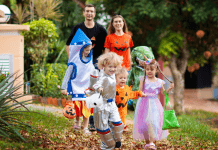
Last week was Child Passenger Safety Awareness Week and we partnered with Toyota and Rady’s Children Hospital to share the importance of child passenger safety.
We had the privilege of hearing from the Transportation Safety Program at Rady Children’s Hospital at Toyota of El Cajon this past Wednesday and we wanted to share some key takeaways that we learned at the event. Child Passenger Safety Awareness Week highlights the importance of ensuring that all children are properly secured in an appropriate car seat or seatbelt. When it comes to child safety, it is better to be safe than sorry.
Head over to the San Diego Moms Blog Instagram and take our Child Passenger Safety Quiz!!
Here are five key takeaways we thought every mom should know:

- Motor vehicle crashes are a leading cause of death due to unintentional injury in children ages 5-14 in San Diego County. While not all motor vehicle crashes are survivable, the use of an age-appropriate, properly installed child passenger safety seat reduces the risk of death or serious injury by 71 percent.
- In California, children have to stay rear facing until the minimum age of 2 years old, or 40 lbs and 40 inches. Nationally, it is educated that children stay rear facing as long as possible following the manufactured car seat allowance. The goal is protect their head, neck and back.
- Whenever you are placing a child in a 5-point-harness car seat, it’s important to loosen the straps and adjust during each use. Children are growing by the minute and the straps aren’t one-size-fits-all.
- A child passenger must be in a safety restraint, in the back seat, until they reach 8 years old unless they are 4 feet, 9 inches tall or taller. Nationally the recommendation is that children under age 13 should ride in the back seat for maximum safety.
- LATCH stands for Lower Anchors and Tethers for Children. LATCH is required on car seats (up to a set weight – please check your car seat) and in most vehicles manufactured on or after Sept. 1, 2002, to make car seat installations easier.
- Do not buy a used car seat. In case of an accident, make sure to dispose of your car seat and get a new one. (Most insurance companies will replace your car seat.)
- Most car seats are sprayed with flame retardant so there’s a limit to how many time your car seat can be washed. Check your manufacture guide on the limits so the safety of your seat isn’t compromised.
***Always check both your car seat and car manufacturer for the correct installation and use.***
To ensure maximum safety, it’s important to meet with a car seat technician when you buy a new car, a new car seat and/or have a new baby. You can schedule an appointment with a Certified Child Passenger Safety Technician at Rady’s Children Hospital by clicking HERE.
Toyota takes safety seriously. Toyota Safety Sense™ (TSS) is included on many new Toyota vehicles at no additional cost. TSS is a bundle of active safety features designed to help protect you and your passengers from harm. Toyota is dedicated to your child’s safety and in addition to the 5 NEW car seats that were donated to Rady’s Children Hospital, they also donated a check for $1,000 $1,000 that will be used to purchase car seats to donate to local families in need.

















